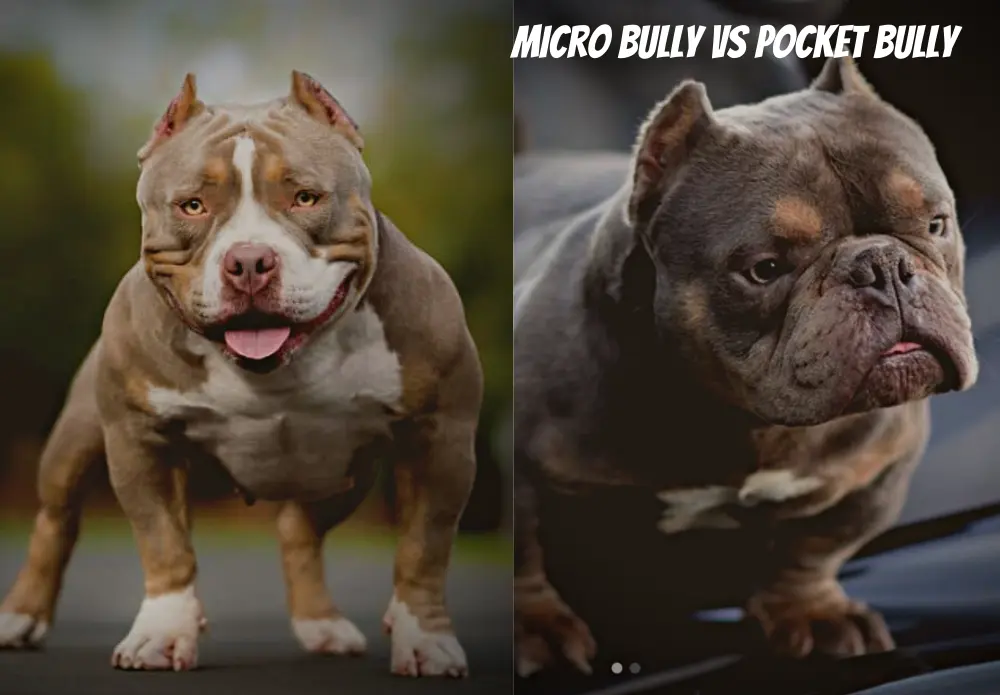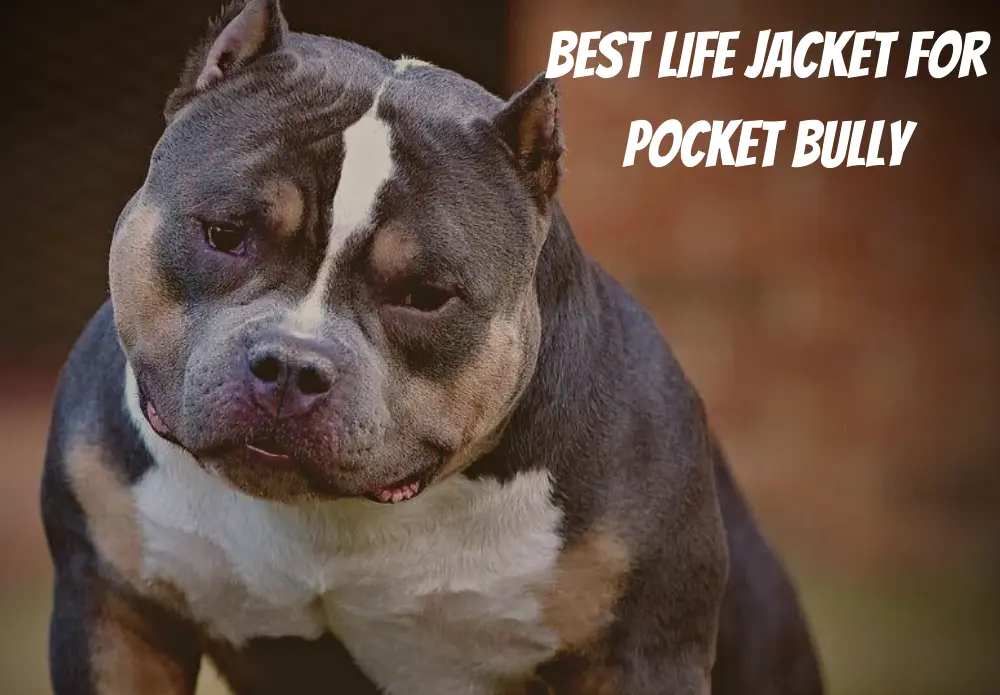As everyone knows, only four classes of American Bullies are officially recognized, and one of these classes is the Pocket Bully. There are also unofficial classes, and Micro Bully is one of these classes.
Today we will compare Micro Bully vs. Pocket Bully and see how they are similar and different from each other. Keep reading everything about these two dogs and understand why there is so much confusion.
Micro Bullly vs Pocket Bully
Both of these dogs are a part of the American Bully family. The Pocket Bully was formed by mixing the American Bully with Patterdale Terrier to get a small-sized Buly in the early 2000s. It became a hit overnight and was considered an official part of the breed.
Later in the 2000s, people started breeding the Patterdale terrier with the Pocket Bully to make the Bully even smaller. After so many attempts, breeders could produce an even smaller version of the Pocket Bully with all the traits of the American Bully except the height.
Although people found the little miniature Bully attractive, officials and ethical breeders objected to the breed as it sets abnormality into the breed.
There is also the confusion that many people mix up the term Micro, Pocket, and Exotic Bully with one another. That is false, as a Micro Bully is a different dog than Pocket but the same breed. While the Exotic Bully is a different breed, it has different genetics.
Physical Appearance
One of the key physical characteristics of an American Bully is a muscular body. For Pocket Bullies and Micro Bullies, this is particularly true.
Both bully breeds have powerful bodies, wide chests, thick necks, and short legs as physical characteristics. Additionally, both of the dogs are short-legged and stocky.
The Pocket Bully is a scaled-down variant of the Standard American Bully, mostly how the two differ. At the same time, Micro Bully is the smallest American Bully. The medium to the long tail of a Pocket Bully is typically docked. A Micro Bully often has a short, natural tail.
Size
Adult male Pocket Bullys must be under 17 inches (43 cm) and no shorter than 14 inches (36 cm) at the withers to meet American Bully Kennel Club (ABKC) requirements. At the withers, females must be under 16 inches (40 cm) and no shorter than 13 inches (33 cm).
Since there is no standard set for Micro Bully, there is no official recorded height. But if you compare it based on the standard of Pocket Bullies, then any American Bully below 13 inches is a Micro Bully.
While the Pocket Bully weighs 20 to 50 pounds for its size, the Micro Bully also weighs the same despite being smaller. This is due to the muscle density in smaller and more compact sizes.
Head and Facial Differences
The Micro Bully’s head is smaller than the Pocket Bully’s. The diameter ratio of Pocket Bully dogs is typically 60% or higher compared to their shoulder height.
On the other side, the Micro Bully has a smaller head. The diameter-to-shoulder height ratio for them is typically 50% or less. Eyes American Pocket Bullies often have round widely spaced eyes.
A Micro Bully has wide-set eyes that are more almond-shaped than round. Pocket bullies typically have clipped ears that are high on the head. Micro bullies also have high-set ears, although they typically have natural, uncropped ears.
Coat and Color
Both Pocket and Micro Bully have short and smooth coat that does not shed too much. They also come in all colors, as there is no limit to colors and patterns. Here are some of the colors these dogs can have.
Black: On practically the entire body, the predominant coat color is lustrous black. The face, chest, and paws frequently have white markings.
Chocolate: Nearly the entire body is covered in a thick chocolate layer. White markings can be visible on the face, chest, paws, and black coat.
Blue: Puppies with blue coats don’t have blue coats; instead, they have a grey color that looks blue. It resembles the blue coat of German shepherds.
White: Although most of these dogs are white, you may occasionally see them with spots or patterns of other colors, such as black.
Brindle: These include black, red, and blue brindles. The typical brindle pattern typically consists of lighter brown tint stripes. The tiger is frequently said to have a brindle pattern.
Tri-color: Three colors can be seen on the coats of pit bulls with the tri-color pattern. Usually, tan and white are added to a foundation hue of blue or black. Black is the most typical basic color. Tan hues can be seen on the snout, chest, legs, and area over the eyes. On the chest, there is typically some white visible.
Merle: Due to a mutation, merle dogs are exceedingly uncommon. Puppies with these patterns have spots of a darker hue on top of a base coat of diluted colors, which may be blue or red. Their eyes are blue as well.
Personality
For a long time, people have claimed that Pitbulls are aggressive, and that trait has been passed down to American Bullies.
This belief comes from their bull-baiting history. Humans indeed raised Pitbulls to be dog fighters, but in reality, they are one of the loveliest and most caring breeds.
Nowadays, you will likely find American Bullies in homes cuddling up next to their owner rather than causing trouble. A similar is true of the Pocket Bully and Micro Bully; making trouble is not their thing.
Because they were taught to be devoted and watchful friends, Pocket and Micro American Bullies acquired their image as “nanny” dogs.
Pocket Bullies will more likely keep your children from danger, which is why they are such great family dogs. They have big hearts and will care for you and your family no matter what.
Inside those tiny bodies of Micro Bullies is a lot of affection, and they will not stop showing you how much they love you.
Caring & Traning for Pocket and Micro Bully
Caring for a Pocket Bully and Micro Bully is easy, but they still have lots of energy and need exercise. Pocket Bullies also need a good diet, adequate training, and a fair share of your time.
Training
As soon as you bring your Pocket Bully home, you can start with his obedience training so he knows who the real boss of the house is. After eight weeks, you can teach him tricks and other skills such as sitting, standing, staying, and leaving.
You can teach him how to play and greet other people and dogs, which will significantly help with socializing him. You can enroll your Pocket Bully puppy in a training school where he will learn basic manners and make new friends.
Exercise
Exercise is crucial in maintaining that iconic Bully body. Pitbulls were bred as working dogs, and that characteristic has found its way to American Bullies, so your Pocket Bully has lots of energy that needs to be channeled somewhere.
Therefore, you should exercise your Pocket Bully puppy for at least 30 minutes daily by taking him on walks, jogs, or swimming. You can also buy toys to distract him and exhaust all that extra energy.
Remember, a dull dog will always develop depression and aggressive behavior that can lead to destruction. So, keep your Pocket Bully engaged with one thing or another throughout the day, and remember to spend some time with him.
Here are a few activities you can do with your Pocket size American Bully for exercise and training.
- Swimming
- Running
- Playing fetch
- Going to the park
- Play tug of war with your dog
- Teach your dog obedience commands
- Hiking
- Jogging
- Agility Training
- Search and Rescue Training
- Ride a Bike with Your Dog
- Cross-Country Skiing with Your Dog
- Dog Frisbee/Disc Golf
- Canine Musical Freestyle
- Flyball Competition
Grooming
Pocket American Bullies require professional grooming to keep their coat short, smooth, and clean. Brush your Bully’s skin once a week, check their ears for wax build-up and infection, brush their teeth, and trim their nail every two weeks.
The Pocket American Bully is a fabulous family dog loyal, protective, and easy to train. You can have a healthy and perfect dog for your family with a little effort and grooming.
Diet
A healthy, full-of-nutrition diet is critical for a Pocket Bully to develop and sustain that muscular build and skeletal structure. You cannot keep your pocket bully hungry and exercise him simultaneously.
You must feed your Bully puppy at least three times a day and feed him a diet with lots of meats and fruits. A single-serving meal for your American Pocket Bully should contain at least 30% protein and 20% fat with essential carbs for daily energy.
You can also supplement his diet by adding calcium supplements and vitamins.
Cost of Pocket Bully and Micro Bully
A typical Pocket Bully puppy’s price range is between $3,000 and $8,000. At the same time, the price for a Micro Bully starts from $5,000 to $12,000.
Also, different colors have another price tag, with some adding up to $10,000 to the original price.
FAQs – Frequently Asked Questions
Is a Micro Bully the Same as A Pocket Bully?
No, the Micro Bully is a different dog of the same breed as the Pocket Bully. While both Bullies belong to the American Bully breed, Micro Bully is smaller than 13 inches, and the Pocket is between 13 to 17 inches.
Micro Bully is a result of mixing a Patterdale Terrier with a Pocket bully, while the Pocket bully is a result of combining a Standard Bully with a Patterdale Terrier.
What 2 Breeds Make a Micro Bully?
Micro Bully was first produced by mixing Pocket Bully with Patterdale Terrier to make the Pocket Bully even smaller.
What Is the Smallest Bully Breed?
If you go by the official standards, Pocket Bully is the smallest Bully with a height of 13 to 17 inches. But if you go for the collective answer of both official and unofficial breeds, then Micro Bully is the smallest, with a height between 10 to 13 inches.
Conclusion
Both Pocket Bully and Micro Bully are amazing pets and are almost similar. The key difference is in the size and recognition of both. If you want to choose either one, select it based on your need and the space in your house.






